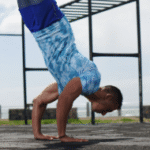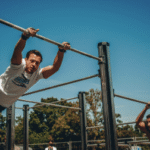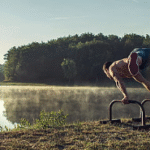What Really Happens During a One-on-One Calisthenics Session?
- The Initial Check-in & Assessment (5-10 minutes): Beyond Just Greetings
The session begins with a focused dialogue that sets the stage for the workout:
Verbal Check-in: Your coach will ask about your previous week’s training, your energy levels, any new muscle soreness or aches, sleep quality, and external stressors (common for busy Houston professionals). This immediate feedback allows the coach to make real-time adjustments to the day’s plan.
Review of “Homework”: If you were given drills or mobility work to do independently, the coach will inquire about your progress and any challenges encountered.
Quick Movement Screen/Mobility Assessment: The coach might observe a few specific movements to assess your current mobility or how a particular joint is feeling that day (e.g., shoulder mobility for overhead skills, wrist extension for handstands). This ensures safety and optimal preparation for the session.
—
- The Warm-up (10-15 minutes): Purposeful Preparation
This isn’t just light cardio. The warm-up is a carefully structured prelude designed to prime your body for the specific demands of the session:
Dynamic Mobility Drills: Active movements through your joints’ full range of motion (e.g., arm circles, leg swings, spinal twists, cat-cow stretches). These are specifically chosen to prepare the joints and muscles that will be heavily utilized in the day’s skill work and strength training.
Specific Muscle Activation: Exercises designed to “wake up” and engage key muscles that might be dormant or underactive (e.g., band pull-aparts for shoulder external rotators, glute bridges for hip activation).
Low-Intensity Skill Drills: For advanced skills, the warm-up might include very easy versions of the actual movements (e.g., hollow body holds on the floor before attempting on the bar, light wrist rocks for handstands) to prime the nervous system.
Joint Preparation: Meticulous attention to joint-specific warm-ups, especially for wrists (wrist circles, extensions, flexions) and shoulders (scapular protractions/retractions), which are heavily involved in calisthenics.
—
- The Core of the Session – Skill Work & Strength Training (30-45 minutes): The Main Event
This is where the magic happens, and the personalization truly shines. The coach fluidly moves between skill acquisition and strength building, constantly adapting to your performance:
Skill Work (The Calisthenics Focus):
Breaking Down Complex Skills: If you’re learning a handstand, muscle-up, planche, or front lever, the coach will meticulously break it down into its component parts and prerequisites.
Targeted Drills: You’ll perform specific drills designed to isolate and strengthen the weakest links of the skill (e.g., wall handstand holds for alignment, arch hangs for back lever, false grip hangs for muscle-ups).
Progressive Regressions & Progressions: The coach knows hundreds of variations. If a movement is too difficult, they’ll immediately provide a simpler, effective regression. If you’re excelling, they’ll challenge you with a harder progression or a new variation.
Meticulous Form Correction: This is continuous. The coach provides constant, precise verbal cues (“squeeze your glutes,” “push the floor away,” “keep your core tight”), tactile cues (gently touching a muscle to help you feel the contraction), and visual cues (demonstrating the movement perfectly). They stop you mid-rep if form breaks down.
Spotting for Safety and Confidence: For challenging or inverted movements, the coach provides physical spotting, allowing you to attempt holds or transitions with confidence, significantly reducing the fear factor and preventing falls or injuries.
Video Analysis: Many coaches will record your sets, especially for skill work, and review them with you on the spot or after the session. This visual feedback is incredibly powerful for identifying and correcting form flaws, accelerating learning.
Strength Training (Building the Foundation):
Compound Bodyweight Exercises: You’ll perform a selection of fundamental pushes (e.g., push-up variations, dips), pulls (e.g., pull-up variations, rows), leg exercises (e.g., pistol squats, lunges), and core work (e.g., L-sits, hollow body holds).
Manipulating Variables: The coach controls sets, reps, Time Under Tension (TUT – by prescribing specific tempos), rest intervals, and intensity (using RPE – Rate of Perceived Exertion) to optimize for hypertrophy, strength, or endurance, depending on the mesocycle.
Weighted Calisthenics: For advanced clients, external weight (vests, dip belts) might be incorporated into exercises like pull-ups and dips to drive further strength and muscle growth.
Personalized Programming in Action: The coach dynamically adjusts the workout based on how you’re performing that day . If you’re fatigued, they might reduce volume or intensity. If you’re feeling strong, they might challenge you with a new progression.
—
- Conditioning / Accessory Work (5-10 minutes): Refinement & Endurance
Towards the end of the main workout, there’s often a segment for higher-rep work or targeted exercises:
Higher Repetition Bodyweight Exercises: To build muscular endurance and increase metabolic stress.
Circuits or Supersets: Combining several exercises with minimal rest for cardiovascular and muscular conditioning.
Specific Accessory Exercises: Drills designed to address identified weaknesses or imbalances that might hinder skill acquisition or cause injury (e.g., rotator cuff exercises for shoulder stability, forearm conditioning for grip strength).
—
- Cool-down & Mobility (5-10 minutes): Recovery & Adaptation
The session concludes with essential steps for recovery and flexibility:
Static Stretching: Holding stretches for the main muscle groups worked, to improve flexibility and aid in muscle relaxation.
Longer-Hold Mobility Drills: Specific exercises to improve active range of motion in key joints (e.g., hip flexor stretches, shoulder capsule mobility).
Foam Rolling / Self-Myofascial Release (SMR): The coach might guide you through SMR techniques to release muscle tightness and improve blood flow.
Brief Debrief on Next Steps: A quick discussion about how you’re feeling and the plan for the upcoming days.
—
- The Post-Session Debrief & Homework (5 minutes): Beyond the Hour
The coaching doesn’t end when the workout does:
Session Review: The coach will summarize the highlights of the session, discuss successes, and acknowledge challenges.
Homework & Next Steps: You’ll typically receive “homework” – specific mobility drills, foundational exercises, or active recovery strategies to perform independently before your next session. This ensures continuous progress.
Reinforcement of Holistic Strategies: Discussion about the importance of nutrition (fueling performance and recovery), hydration (crucial in Houston’s climate), and adequate sleep.
Scheduling: Confirming the next session.
Houston Context:
In Houston, you can experience this detailed session structure in various settings. Your coach might operate from a specialized calisthenics studio (like Calisthenics & Lifestyle Club Houston), utilize Houston’s expansive public parks (like Memorial Park with its outdoor fitness areas), or even conduct sessions in your home or apartment gym. Regardless of location, the core elements of personalization and expert guidance remain constant, ensuring you get the most out of every minute.
—
Conclusion: A Comprehensive and Tailored Experience
A one-on-one calisthenics session is a comprehensive, meticulously planned, and dynamically executed experience. It’s not just about doing exercises; it’s about learning, adapting, and mastering your body under the precise guidance of an expert. From the initial check-in to the post-session debrief, every element is tailored to accelerate your results, optimize your form, prevent injuries, and ultimately, unlock your full physical potential in Houston.

What Really Happens During a One-on-One Calisthenics Session?
Route
Calisthenics Gym Houston Functional Bodyweight Training
Secondary phone: (346) 483-3195
Email: info@calisthenicsclubhouston.com
URL: https://calisthenicsclubhouston.com/
Monday 6:00 AM - 7:00 PM Tuesday 6:00 AM - 7:00 PM Wednesday 6:00 AM - 7:00 PM Thursday 6:00 AM - 7:00 PM Friday 12:00 PM - 6:30 PM Saturday 9:45 AM - 12:00 PM Sunday 3:00 PM - 5:00 PM





